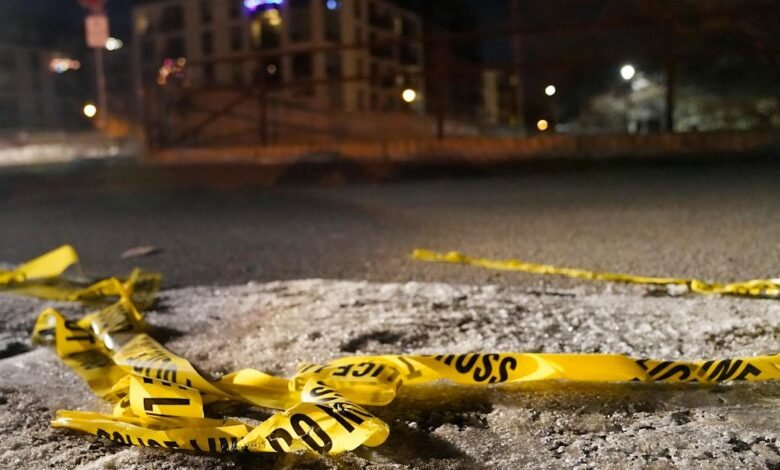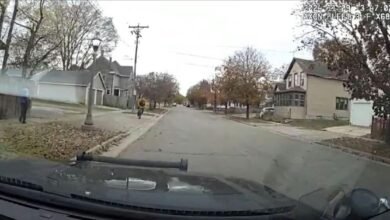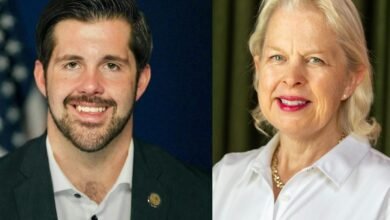
Minneapolis is entering 2024 with a grim outlook for its police force, but what that bodes for crime rates remains to be seen.
The number of active officers in the Minneapolis Police Department has fallen to 565 — down from nearly 900 in 2019 — an exodus that is exacerbating what the chief repeatedly warns is an unsustainable long-term calculus for public safety in Minnesota’s largest city.
But while violent crime remains above pre-pandemic levels, it dropped in Minneapolis for the second consecutive year in 2023, more evidence that the latest wave of murders, shootings and carjackings is receding.
In an election year where policing and public safety will be paramount to campaign messaging, criminologists who study these trends say the juxtaposition reflects the complicated, often misunderstood nature of what drives the ebb and flow of crime. The number of police officers is one of a vast universe of factors that also includes economics, social services, housing access and macro changes in human behavior.
“Violent crimes rise and fall for many, many reasons,” said Aaron Chalfin, a criminologist at the University of Pennsylvania. “Some of those reasons are well understood. Some are not.”
In 2021, Chalfin set out to measure what role police staffing plays. Through 38 years of data from 242 law enforcement agencies, he and others concluded that every 10 to 17 additional hires translated to one life saved. But more officers also created “collateral costs,” such as a disproportionate jump in low-level arrests in minority neighborhoods that bred distrust and hurt safety perceptions, according to the study published in American Economic Review: Insights. The researchers also cited evidence that more police can lead to a rise in discriminatory practices, including the use of force on Black suspects.
When violent crime surges in American cities, calls to beef up police resources generally follow, based on conventional wisdom that more officers mean safer streets. But it can be difficult to disentangle the role of cops vs. other deterrents, like additional funding for youth programs or drug treatment. Adversely, a drop in police ranks can affect residents’ perception of safety as depleted resources are reallocated. Fewer property crimes go investigated and solved, while more serious cases may take even longer.
“Police are kind of stop-gap measure that gets sent in when all of the other supports that are supposed to prevent crime in the first place have failed,” said Michelle Phelps, a sociology professor at the University of Minnesota, who recently finished a book on Minneapolis police reform.
In Minneapolis, Phelps’ research found a weak correlation between force size and homicides, as historically murders rose and fell even while the number of uniformed officers stayed relatively constant — that is, until the unprecedented events of 2020.
Phelps said residents and police must be realistic about what law enforcement can accomplish. Police chiefs control where and how to deploy officers — but they have no authority over greater societal factors driving crime.
Staffing crisis
The COVID-19 pandemic upended society by displacing children from school, economically destabilizing their parents and fueling a sense of despair that drove spikes in overdoses and suicides. George Floyd’s murder inflamed tensions in a community already on edge.
What followed were three of the bloodiest years in the city’s history — as homicides surged to the worst in a generation — and officers left the force in droves. The wave of resignations, retirements and disability claims by police, mostly related to post-traumatic stress disorder, shrunk the department by nearly 40%.
MPD now has among the lowest ratio of officers to residents in the nation, fundamentally changing how the department operates. Top brass leaned on state and county law enforcement partners to fill the gaps and hired part-time civilian analysts to review video evidence.
Last fall, Chief Brian O’Hara combined the homicide unit and shooting response team— a stand-alone outfit dedicated to nonfatal gun violence — to pool resources against agrowing caseload. But when each day is about triaging 911 calls, O’Hara said, patrol officers can’t spend as much time at crime scenes or responding to victims’ families.
“Where it hurts is just trying to bring some sense of justice” to murder victims, O’Hara said in an interview. “We’re failing them by not having sufficient resources to really go after those cases and respond to those scenes the way we should be.”
Last year, the department racked up $22 million in overtime costs — about half of which were filed under “critical staffing overtime,” where officers are paid double their hourly wage.
Reliance on overtime has created a cycle, O’Hara said: Burnout can expedite staff turnover, which drives the need for more overtime. “The only way to break out of it,” the chief said, “is to get more people in the door.”
Chalfin said the study he co-authored can’t answer a critical question: Is there an inflection point where a police department becomes so small it fails to perform basic functions, resulting in a greater magnitude of crime increase?
“It stands to reason,” the criminologist said, but research can only look to the past, and there is not enough data to say for certain.
Ebbs and flows
As the police force shrunk in 2023, crime fell across Minneapolis compared to 2022, with murders declining 8%, robberies dropping 20%, shootings down by 25% and carjacking reports nearly cut in half.
Those improvements come with caveats: Some nonviolent crimes continued to rise last year; auto thefts, for example, saw the highest rate in the city’s history, averaging almost one stolen car every hour of 2023.
Last year also finished with a violent fourth quarter: 28 killings in three months brought Minneapolis to 76 homicides, according to a Star Tribune database that also counts police killings and civilian self-defense cases.
It’s not the first time crime ebbed in the opposite direction of police staffing levels. In the 1980s, as cities across the United States saw violent crime rising, Minneapolis bolstered its ranks by about 30% by 1994.
With more police than ever, the city’s murder rate still rose to the highest in history — higher than 2021, the peak of the current crime wave — cresting in 1995. That surge of violence subsided as quickly as it had emerged, dropping by half by the early 2000s, as police staffing also fell.
The number of sworn officers started dipping again in the 2010s. By 2018, violent crime in Minneapolis hit the lowest rates in at least four decades.
The police budget continued to climb even as staffing strength atrophied. The 2024 budget allocates $217 million to fund an authorized force of 731 officers, as required under the city’s charter — a number that the city is unable to meet due to the staff exodus and recruitment struggles.
At the same time, the city has invested more money in alternatives to traditional policing. From 2020 to 2024, the budget for the Neighborhood Safety Office, which addresses violence through a public health lens, soared from $2.7 million to more than $23 million.
Quantity and quality
The debate over police staffing dates back before the crime spike.
In 2019 — when the Minneapolis Police Department counted almost 900 officers — then-Chief Medaria Arradondo appeared before the City Council to ask for 400 more patrol officers by 2025.
In an interview, Arradondo said he saw warning signs of a staffing crisis even then.
By the time he retired in late 2021, the department lacked the capacity to maintain anymore foot patrols in the city. “No reasonable person could make the case that Chief O’Hara currently has adequate staffing,” he said.
KB Brown, owner of Wolfpack Promotionals, a north Minneapolis marketing company, said city leaders are too fixated on the numbers game of policing. He believes the city needs more officers, but says crime must also be stopped at the source through programs that provide kids with jobs and guidance.
He also emphasized his desire for “quality of quantity,” and a need to rid police of a warrior-style mentality.
“Our officers should be the gold standard in law enforcement,” he said. “We understand that we can’t do it without them, and they need to understand they can’t do it without us.”
Source link



